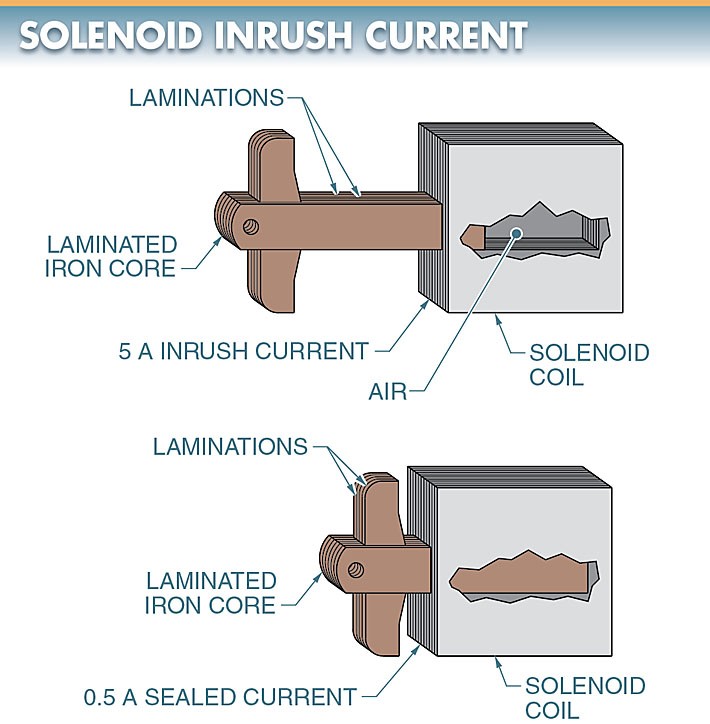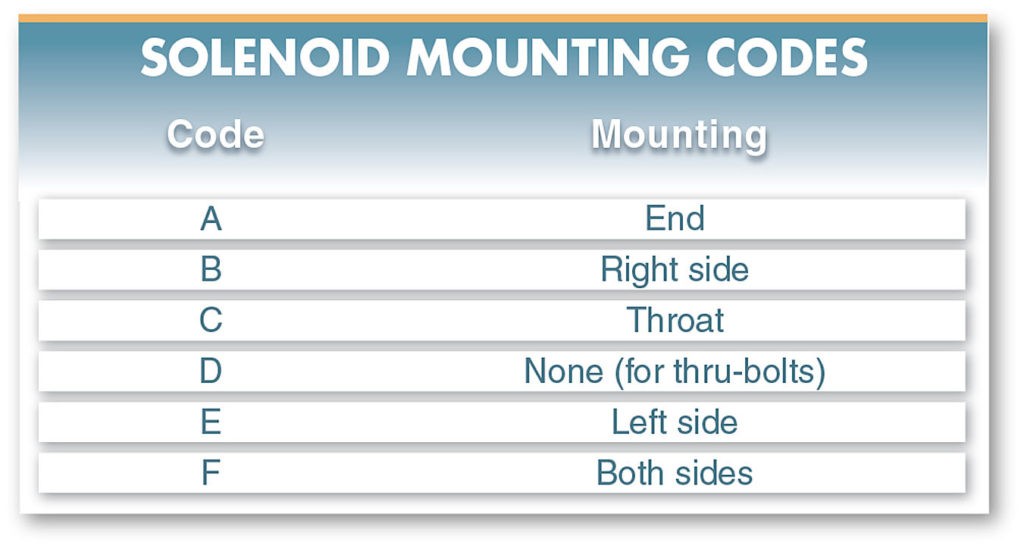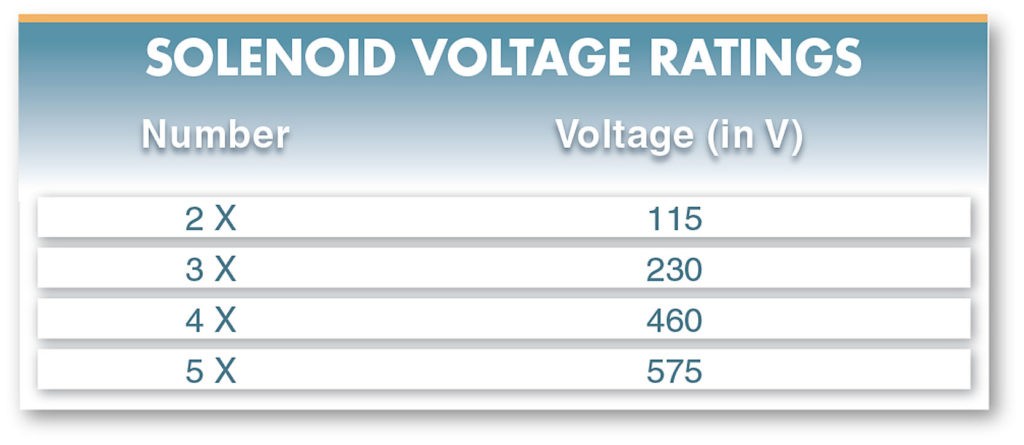The two primary characteristics of a solenoid are the amount of voltage applied to the coil and the amount of current allowed to pass through the coil. Solenoid voltage characteristics include pick-up voltage, seal-in voltage, and drop-out voltage. Solenoid current characteristics include coil inrush current and sealed current.
Coils
Magnetic coils are normally constructed of many turns of insulated copper wire wound on a spool. The mechanical life of most coils is extended by encapsulating the coil in an epoxy resin or glass-reinforced alkyd material. See Figure 1. In addition to increasing mechanical strength, these materials greatly increase the moisture resistance of the magnetic coil.
Because magnetic coils are encapsulated and cannot be repaired, they must be replaced when they fail.
Figure 1. The mechanical life of most coils is extended by encapsulating the coil in an epoxy resin or glass-reinforced alkyd material.
Coil Inrush and Sealed Currents
Solenoid coils draw more current when first energized than the amount that is required to keep them running.
In a solenoid coil, the inrush current is approximately 6 to 10 times the sealed current. See Figure 2. After the solenoid has been energized for some time, the coil becomes hot, causing the coil current to fall and stabilize at approximately 80% of its value when cold. The reason for such a high inrush current is that the basic opposition to current flow when a solenoid is energized is only the resistance of the copper coil. Upon energizing, however, the armature begins to move iron into the core of the coil. The large amount of iron in the magnetic circuit increases the magnetic opposition of the coil and decreases the current through the coil. This magnetic opposition is referred to as inductive reactance or total impedance. The heat produced by the coil further reduces current flow because the resistance of copper wire increases when hot, which limits some current flow.
Figure 2. Solenoid inrush current is approximately 6 to 10 times the sealed current.
Coil Inrush and Sealed Current Ratings
Magnetic coil data is normally given in volt amperes (VA). For example, a solenoid with a 120 V coil rated at 600 VA inrush and 60 VA sealed has an inrush current of 5 A (600/120= 5 A) and a sealed current of 0.5 A (60/120 = 0.5 A). The same solenoid with a 480 V coil draws only 1.25 A (600/480= 1.25 A) inrush current and 0.125 A (60/480= 0.125 A) sealed current. The VA rating helps determine the starting and energized current load drawn from the supply line.
Tech Fact
Solenoids are rated for intermittent or continuous duty. An intermittent-duty solenoid is designed to produce a strong force in a small package but will overheat if current is continuously applied to the coil. A continuous-duty solenoid is designed to handle a continuous current but is larger to help dissipate the heat produced.
Coil Voltage Characteristics
All solenoids develop a magnetic field in their coil when voltage is applied. This magnetic field produces a force on the armature and tries to move it. The applied voltage determines the amount of force produced on the armature.
The voltage applied to a solenoid should be ±10% of the rated solenoid value. A solenoid overheats when the voltage is excessive. The heat destroys the insulation on the coil wire and burns out the solenoid. The solenoid armature may have difficulty moving the load connected to it when the voltage is too low.
Pick-up voltage is the minimum voltage that causes the armature to start to move.
Seal-in voltage is the minimum control voltage required to cause the armature to seal against the pole faces of the magnet.
Drop-out voltage is the voltage that exists when voltage is reduced sufficiently to allow the solenoid to open.
Seal-in voltage can be higher than pick-up voltage because a higher force may be required to seal in the armature than to just move the armature.
Drop-out voltage is lower than pick-up voltage or seal-in voltage because it takes more force to hold the armature in place than to release the armature.
For most solenoids, the minimum pick-up voltage is about 80% to 85% of the solenoid rated voltage.
The seal-in voltage is somewhat higher than the pick-up voltage and should be no less than 90% of the solenoid rated voltage.
Drop-out voltage can be as low as 70% of the solenoid rated voltage.
The exact pick-up, seal- in, and drop-out voltages depend on the load connected to the solenoid armature and the mounting position of the solenoid. The greater the applied armature load, the higher the required voltage values.
Voltage Variation Effects
Voltage variations are one of the most common causes of solenoid failure. Precautions must be taken to select the proper coil for a solenoid. Excessive or low voltage must not be applied to a solenoid coil.
Excessive Voltage
A coil draws more than its rated current if the voltage applied to the coil is too high. Excessive heat is produced, which causes early failure of the coil insulation. The magnetic pull is also too high and causes the armature to slam in with excessive force. This causes the magnetic faces to wear rapidly, reducing the expected life of the solenoid.
Low Voltage
Low voltage on the coil produces low coil current and reduced magnetic pull. The solenoid may pick up but does not seal in when the applied voltage is greater than the pick-up voltage but less than the seal-in voltage.
The greater pick-up current (6 to 10 times sealed current) quickly heats up and burns out the coil because it is not designed to carry a high continuous current. The armature also chatters, which creates noise and increases the wear of the magnetic faces.
Solenoid Selection Methods
Solenoids are selected based on the outcome required. It is important to select the correct solenoid to achieve the desired outcome. Solenoid selection methods include push or pull, length of stroke, required force, duty cycle, mounting, and voltage rating.
Push or Pull.
A solenoid may push or pull, depending on the application. In the case of a door latch, the unit must pull. In a clamping jig, the unit must push.
Length of Stroke
The length of the stroke is calculated after determining whether the solenoid must push or pull. For example, a door latch requires a Z\x′′ maximum stroke length.
Required Force
Manufacturer specification sheets are used to determine the correct solenoid based on the required force. A solenoid is selected from the manufacturer specification sheets based on required solenoid function.
Duty Cycle
Solenoid characteristic tables are also used to check the duty cycle requirements of the application against the duty cycle information given for the solenoid. For example, an A 101 solenoid is required for an application requiring 190 operations per minute.
Mounting
Manufacturers provide letter or number codes to indicate the solenoid mount. See Figure 3. For example, an A solenoid is selected for a door latch application because the door latch application requires an end-mounting solenoid.
Figure 3. Manufacturers provide letter or number codes to indicate the solenoid mount.
Voltage Rating
Manufacturers provide letter or number codes to indicate the voltages that are available for a given solenoid. See Figure 4. For example, a 2 A solenoid may be used for an application that requires a 115 V coil.
Figure 4. Manufacturers provide letter or number codes to indicate the voltages that are available for a given solenoid.




